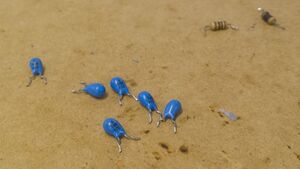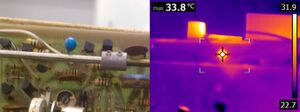Capacitor Types
Capacitors come in many varieties that can differ not only physically but chemically, electrically, and mechanically as well. It is possible to substitute some kinds of capacitors with others, but not always, and it may not always be practical or a good idea. Here are some of the different kinds of more common capacitors you may encounter
Electrolytic/Aluminum/Wet
Identification:
These are the most common type of failed capacitor and have been the most widely used. They may come as a through hole part with pins that extend through the board or as surface mount with legs that are soldered flush. They are cylindrical with the through hole versions having a sleeve over the "can" with the markings printed on it and the SMD versions being metal with direct printing in black. The position of the pins is can be different with radial having them both on one side and axial having them on opposite ends. For some axial capacitors, in audio applications mostly, you may additionally encounter bipolar capacitors.
Polarity:
Polar. Negative side on electrolytic capacitors is marked. Some audio applications use bi-polar capacitors that are non-polar
Significant Specifications(In order of importance):
- Capacitance
- Voltage
- Max Temperature
- ESR (equivalent series resistance)
- Ripple Current
Information:
Electrolytic capacitors have a fluid that acts as a conductor to the cathode but also serves to maintain a dielectric layer with the anode. The anode is a sheet of aluminum rolled up inside of the can. The dielectric is formed as an oxide layer where the electrolyte contacts the anode and a voltage across the capacitor consumes electrolyte to "heal" the dielectric. Because of the chemistry of how the dielectric is maintained these capacitors are "polar" meaning they have positive and negative sides that must be connected to the higher and lower voltages respectively. Getting this backwards can be disastrous. Bi-polar caps are a essentially a hybrid part with two capacitors connected to each other and are non-polar as a result.
Polymer
Identification:
Similar to electrolytic but are more likely to be only metal on the outside with the markings printed with a color instead of black. The SMD versions are most common but they are available in rectangular SMD parts and less commonly radial through hole. These group also includes some Tantalum capacitors which I've broken out to their own description.
Polarity:
Polar. Negative side on can polymer capacitors is marked. Positive side on rectangular polymer capacitors is marked.
Significant Specifications(In order of importance):
- Capacitance
- Voltage
- Max Temperature
- ESR (equivalent series resistance)
- Ripple Current
Information:
There are a number of capacitors of different types in the categories so identification of exactly what kind it is will make replacing it correctly more effective. The can package versions of these capacitors are most likely to fail by leaking, especially earlier SMD examples. They can also fail short due to aging. Rectangular capacitors are more likely to increase in ESR until they either stop working, short, or pop. All of the polymer capacitors have reduced self "healing" capabilities compared to the wet aluminum electrolytic capacitors.
Tantalum
Identification:

Rectangular SMD versions are typically larger than SMD resistors. Through hole versions will look dipped in a coating and may have three legs. All models commonly yellow, rectangular may be black and dipped may be blue.
Polarity:
Polar. Positive side on rectangular and dipped tantalum capacitors is marked.
Significant Specifications(In order of importance):
- Capacitance
- Voltage
- Max Temperature
Information:

These capacitors are more common in older devices when tantalum capacitors had higher energy densities and better ESRs than other capacitor technologies available at the time, however in newer devices those have been mostly replaced by modern high capacitance MLCCs. Tantalum capacitors can be more reliable in certain applications than other capacitors but do fail. They may fail gradually with slowly increasing leakage current and then eventually short from aging even without use, especially older ones. This failure mode can stress upstream regulation components causing excessive dissipation and damage or in catastrophic failure modes the capacitor can reach extreme temperatures damaging the PCB and adjacent components. Some may naturally fail open or low capacitance with how they deplete.
Ceramic
Identification:
SMD parts are brown and typically unlabeled. Through hole are a tan disc or square shaped
Polarity:
Non-polar.
Significant Specifications(In order of importance):
- Capacitance
- Voltage
- Max Temperature
Information:
These capacitors don't fail often. They chemically simpler than the other capacitors and don't have a depleting component.
Paper
Identification:
Can be very large and may look like cardboard. Smaller examples may be dipped in epoxy.
Polarity:
Polar. Negative side marked.
Significant Specifications(In order of importance):
- Capacitance
- Voltage
- Max Temperature
Information:
Paper capacitors vary wildly in appearance and size. They can fail in extremely visible ways as they are susceptible to expansion and moisture intrusion. The epoxy coated examples may overheat and rapidly expand...or...explode. Exact replacements are likely not available.